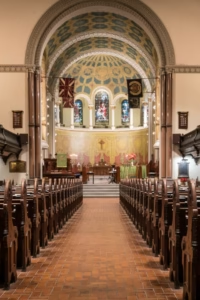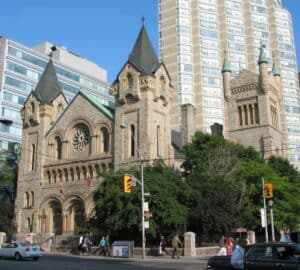
St. Andrew’s Presbyterian Church, located prominently at King and Simcoe Streets, is far more than an architectural landmark; it is a historic pillar in downtown Toronto with a deep military and civic legacy. The congregation, formally established in 1830, played a foundational role in the history of the 48th Highlanders of Canada regiment, an association that began in 1891. The church provided crucial organizational support for the unit’s formation, establishing an immediate and enduring bond.
This profound connection continues today, with the church affectionately known as the “regimental church.” A tangible link is maintained by the retired Colours of the Regiment hanging in the chancel and housing the 48th Highlanders Museum in the church basement, where artifacts celebrate the regiment’s distinguished history and accomplishments.
First Church of St Andrew: The Congregation’s Journey

The history of St. Andrew’s begins with its congregation, which was founded in 1830 as the first Church of Scotland congregation in the Town of York (now Toronto). The first building, designed by John Ewart, was erected that same year on the southwest corner of Church and Adelaide Streets.
The congregation’s early years were marked by significant theological and logistical challenges:
-
The Disruption: In 1843, mirroring the major split in Scotland, a portion of the congregation supportive of the Free Church Movement left St. Andrew’s and, shortly thereafter, founded Knox Presbyterian Church.
-
The Organ Controversy: St. Andrew’s also pioneered the use of music in Canadian Presbyterian worship. In 1852, it became the first Presbyterian church in the country to introduce organ music. This move was highly controversial; despite a higher church council ordering its removal, the organ remained in place but was initially unused. The move was partially influenced by the 71st Highland Light Infantry regiment, who attended services and played instrumental music.
-
The Westward Move and Second Split: By the 1870s, the original structure was too small. As Toronto’s core shifted westward, the majority of the congregation decided to build a new church at the current King and Simcoe Streets location, dedicating the new Romanesque Revival building on February 13, 1876. This decision caused a second split; the majority moved to the “New St. Andrew’s,” while a minority (62 of 403 members) remained, becoming known as “Old St. Andrew’s,” which eventually joined the United Church of Canada in 1925.
-
A Center of Influence: The new church flourished under the Reverend D. J. Macdonnell (1870–1896). As an outspoken theologian, Macdonnell pushed the church toward an active social role, making it one of the most influential Presbyterian churches in Canada and leading to the establishment of St. Andrew’s Institute in 1890—a pioneer center for social work in Toronto.
-
Staying Presbyterian: In a definitive moment in Canadian church history, the congregation voted overwhelmingly (94%) to remain Presbyterian in 1925, opposing the union that created the United Church of Canada.
Architectural Context and Toronto Society
 St. Andrew’s Church, designed by William Storm, is an outstanding example of the Romanesque Revival style. Its construction, utilizing Georgetown sandstone and featuring distinctively Scottish flank tower turrets, emphasizes its heritage connection.
St. Andrew’s Church, designed by William Storm, is an outstanding example of the Romanesque Revival style. Its construction, utilizing Georgetown sandstone and featuring distinctively Scottish flank tower turrets, emphasizes its heritage connection.
In the city’s early days, the intersection where St. Andrew’s stands was famously recognized as a hub of Toronto society, embodying the city’s foundational institutions. The four corners were defined by contrasting elements: “Salvation” (St. Andrew’s Church), “Legislation” (Government House), “Education” (Upper Canada College), and “Damnation” (a popular tavern). Despite the surrounding skyscrapers and the rapid urbanization of the Financial and Entertainment Districts, St. Andrew’s remains a dedicated sanctuary and an active downtown ministry, committed to serving the modern community while honouring its historic past.
Notable Parishioners
St. Andrew’s has been a sanctuary and social centre for many of Toronto’s most influential families and civic leaders, giving it a central role in the city’s history. While its Romanesque Revival architecture makes it visually striking, its true significance lies in the notable figures who have walked its aisles, particularly those responsible for the 48th Highlanders’ creation:
Colonel John Irvine Davidson
John Irvine Davidson was perhaps the most crucial link between the church and the regiment. A prominent businessman who served as the vice-president of the Bank of Commerce and president of the Board of Trade (1890–1891), Davidson was also a leading member of the St. Andrew’s congregation.
-
Regimental Founder: Davidson, then a Captain in the 10th Royal Grenadiers, was the unanimous choice to become the regiment’s first commanding officer upon its official authorization in 1891. He commanded the 48th Highlanders from 1891 to 1898.
-
Church Leader: His commitment extended to the church itself, where he was a dedicated member of the Board of Managers, including six years as its Chairman.
Other Prominent Members
Other figures from the Toronto elite contributed significantly to the church’s standing:
-
George Cox: one of Canada’s most influential businessmen as president of the Bank of Commerce and the Canada Life Assurance Co. An influential philanthropist, Cox was instrumental in financing many of the church’s significant renovations and expansions, ensuring its prominence and preservation.
-
The Massey Family: Members of the Massey family, noted for their industrial success and vast philanthropic efforts across Canada, were also key parishioners, adding to the church’s deep connections within the city’s financial and social establishment.
